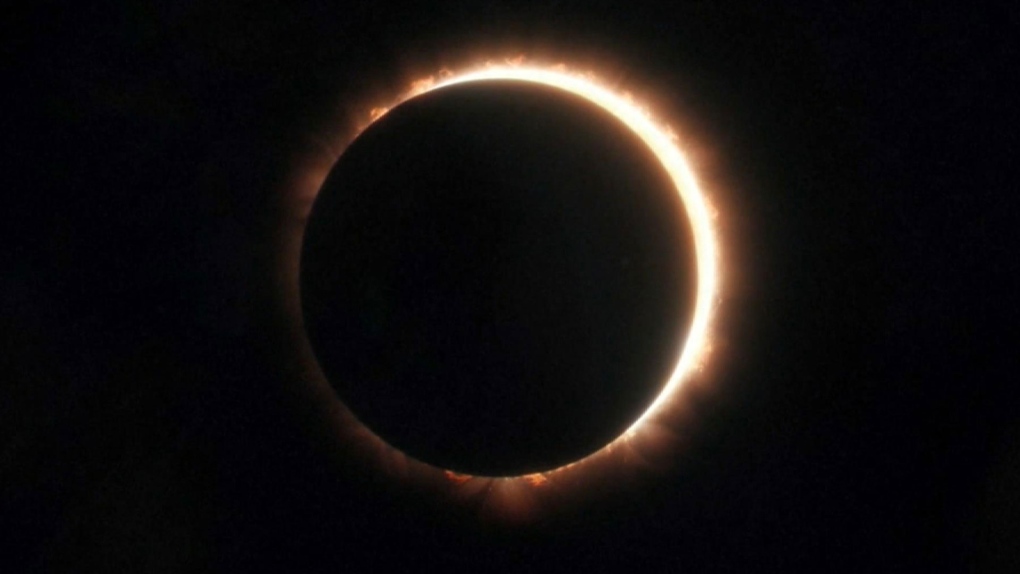How to safely view the solar eclipse using household materials
With the solar eclipse just two weeks away, it’s time to think about how to safely view the celestial show.
For those who aren’t keen on buying solar eclipse glasses, Dr. Ilana MacDonald of University of Toronto’s Dunlap Institute for Astronomy and Astrophysics has an inventory of ways to protect your eyes with household materials.
On April 8, the moon will pass between the sun and the earth. When the moon aligns directly with the sun, it will completely shadow it for several minutes. A partial eclipse will take place just before 2 p.m. in southwestern Ontario, followed by a total eclipse at 3:12 p.m.
“Staring directly at the sun for more than a minute can cause permanent damage to the retina. That means that you'll actually have the back of your eye burned,” MacDonald said.
“And you'll be partially blind in part of your eye.”
One of the ways to keep your vision intact is with a pinhole viewer.
Take a piece of cardstock or index card and punch a hole through it, MacDonald advises. With the pinhole, you can project an image of the sun onto a surface, saving your eyes from looking directly at the luminous rays.
MacDonald recommends punching the hole with a shape that’s not a sphere to clearly see the circle of the sun shine through it.
“You can see that circle turning gradually into a crescent as the moon goes in front of the sun. So in that way, you can safely view the eclipse by projecting its image instead of looking directly at it. We call that an indirect viewing method,” MacDonald said.
To get fancy with it, you can make a shoebox pinhole camera by cutting a hole on one side of a box, putting a piece of aluminum foil over it and then pricking a very small hole in the foil, she said.
 Put it into action by going outside, standing with the sun behind you and letting it shine through the pinhole, projecting the sun onto the other side of the shoebox.
Put it into action by going outside, standing with the sun behind you and letting it shine through the pinhole, projecting the sun onto the other side of the shoebox.
For those less crafty, she said any household object with holes in it will work.
“If you have a colander, or a cheese grater with holes in it or things like that, you can actually project the image of the sun onto a surface using just holes from everyday objects,” she said.
If you are in the path of totality, it's actually safe to view the sun without eclipse glasses, MacDonald noted, but only during totality, the one to three minutes when the moon is completely covering the sun's surface.
The Dunlap Institute is running dozens of free workshops at the Toronto Public Library with a focus on safely viewing the total solar eclipse.
CTVNews.ca Top Stories

More than 115 cases of eye damage reported in Ontario after solar eclipse
More than 115 people who viewed the solar eclipse in Ontario earlier this month experienced eye damage after the event, according to eye doctors in the province.
Toxic testing standoff: Family leaves house over air quality
A Sherwood Park family says their new house is uninhabitable. The McNaughton's say they were forced to leave the house after living there for only a week because contaminants inside made it difficult to breathe.
Decoy bear used to catch man who illegally killed a grizzly, B.C. conservation officers say
A man has been handed a lengthy hunting ban and fined thousands of dollars for illegally killing a grizzly bear, B.C. conservation officers say.
B.C. seeks ban on public drug use, dialing back decriminalization
The B.C. NDP has asked the federal government to recriminalize public drug use, marking a major shift in the province's approach to addressing the deadly overdose crisis.
OPP responds to apparent video of officer supporting anti-Trudeau government protestors
The Ontario Provincial Police (OPP) says it's investigating an interaction between a uniformed officer and anti-Trudeau government protestors after a video circulated on social media.
An emergency slide falls off a Delta Air Lines plane, forcing pilots to return to JFK in New York
An emergency slide fell off a Delta Air Lines jetliner shortly after takeoff Friday from New York, and pilots who felt a vibration in the plane circled back to land safely at JFK Airport.
Sophie Gregoire Trudeau on navigating post-political life, co-parenting and freedom
Sophie Gregoire Trudeau says there is 'still so much love' between her and Prime Minister Justin Trudeau, as they navigate their post-separation relationship co-parenting their three children.
Last letters of pioneering climber who died on Everest reveal dark side of mountaineering
George Mallory is renowned for being one of the first British mountaineers to attempt to scale the dizzying heights of Mount Everest during the 1920s. Nearly a century later, newly digitized letters shed light on Mallory’s hopes and fears about ascending Everest.
Loud boom in Hamilton caused by propane tank, police say
A loud explosion was heard across Hamilton on Friday after a propane tank was accidentally destroyed and detonated at a local scrap metal yard, police say.































